
We have already mentioned that we believe that our Milky Way galaxy is a "spiral galaxy". What does this actually mean? Because we are stuck in the disk of the Milky Way, it is difficult to actually envision this shape. It is much easier to look out at other galaxies to get a better understanding of what is going on in our own galaxy. Let's look at some typical, nearby spiral galaxies, here is M33 again:

M33 has poorly defined spiral arms. But note that they are generally quite blue. Here is another spiral galaxy (M51):

Note the HII regions (pink) in the spiral arms, where young stars are being born. Both M33 and M51 are "face-on" spiral galaxies, that is galaxies that are viewed from above the disk. What do spiral galaxies look like when viewed from "edge-on", in the plane of the disk? Like this (Fig. 20.3):
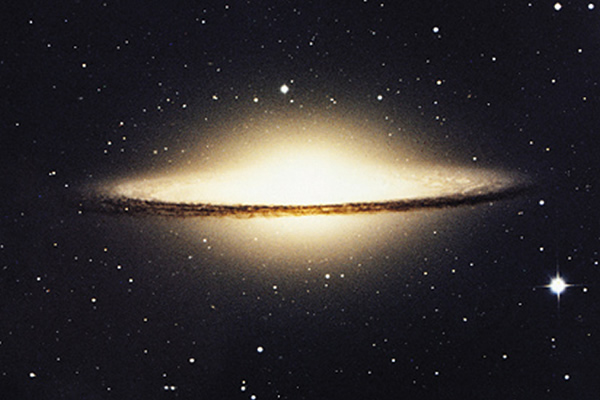
Note that this galaxy (called the "Sombrero galaxy") has a very large bulge of old, reddish stars. When we look at the disk, we see how dusty it is--note how little light penetrates from the bulge through the disk on the side closest to us. All spiral galaxies have a similar structure, a bulge in the center, and a disk containing spiral arms in the outer portions. The difference between spiral galaxies is how bright/big their bulges are, and how tightly their spiral arms are "wound", and this leads to a classification system of spiral galaxies ranging from "S0" to "Sc":1
|
S0 |
Sa
| Sb
| Sc
| |
|---|

S0 galaxies are also sometimes called "lenticular" in that they resemble a magnifying lens (see Fig. 20.5). (After this high resolution HST image of this S0 galaxy was obtained, it was reclassified as an Sa!). Sa galaxies have spiral arms with a little dust, and some star formation regions. They also have large bulges, and their spiral arms are tightly wound:

In this Sa galaxy, you can now clearly see the spiral arms, but they are not very distinct. Some Sa galaxies have arms with star formation regions, but most are dominated by older stars, and they have large bulges. Sb galaxies have weaker bulges, and much stronger arms:
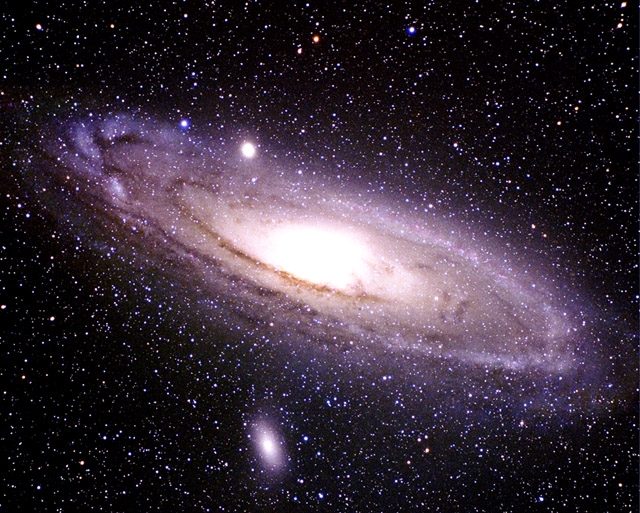
The galaxy pictured above is the great "Andromeda" spiral galaxy. The Andromeda galaxy is the closest, large galaxy to the Milky Way. It is slightly larger and more massive than the Milky Way. Note the blue color of the spiral arms showing that the young stars are the dominant source of light in the spiral arms. Also note the dust content of the Andromeda galaxy is mostly confined to the arms. Sb galaxies still have large bulges. In contrast, Sc galaxies have very small bulges, but are dominated by large, open spiral arms. M33 and M51, shown at the top of this page, are classic examples of Sc galaxies. Sc galaxies are full of young, hot stars, and star formation regions. What is the Milky Way? The Milky Way is believed to be somewhere between an Sb and an Sc galaxy (we would call such an object an Sbc galaxy).
In the picture of the Andromeda galaxy above, you will notice that there are two roundish, fuzzy blobs both above and below the disk of the galaxy. What are these? They are small galaxies! Note, however, that they do not look like spiral galaxies. They belong to the second main class of galaxies called "elliptical" galaxies. Elliptical galaxies in many ways resemble the bulges of spiral galaxies. They do not have disks, and are composed of nothing but old, red stars. Here is a close up on one of those two galaxies orbiting around the Andromeda galaxy (NGC 205):
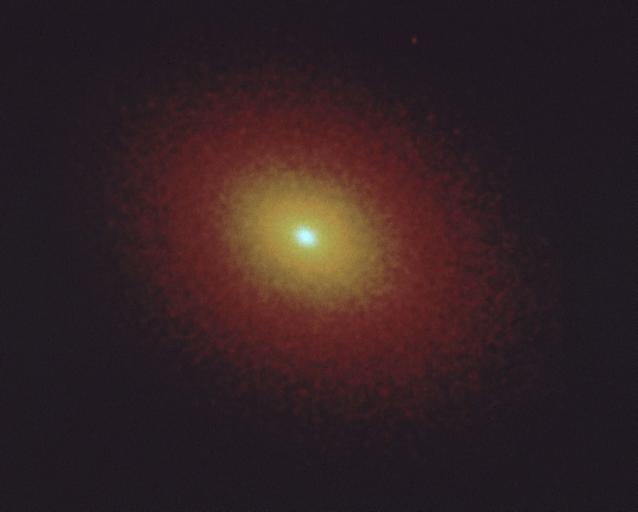
Note how featureless this object is--it has a bright core, and fades into the background at the edges. This is how all elliptical galaxies look. The only differences are how elliptical they are. Elliptical galaxies are classified from E0 (round) to E7 (very ellongated):
|
E0 |
E3
| E7
| |
|---|
Elliptical galaxies come in a range of sizes, for example, NGC 205 is a "dwarf" elliptical galaxy, here is the giant E0 elliptical galaxy M87 (Fig. 20.8a):

It is odd that the largest and smallest galaxies in the universe are elliptical galaxies, here is an example of a tiny elliptical (that has just 10 or 100 times as many stars than a large globular cluster):
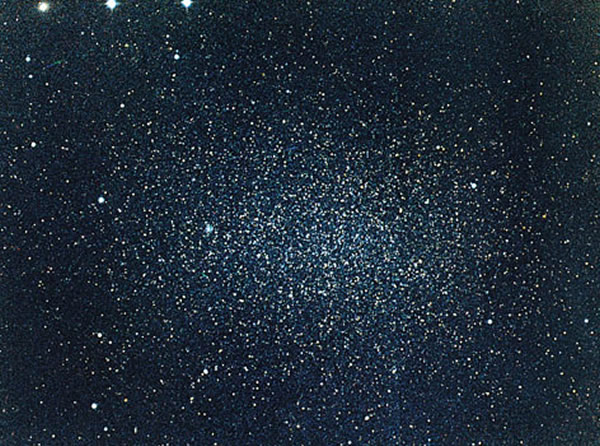
Those little star-like objects around M87 are actually globular clusters. M87 has hundreds of them. A galaxy like M87 has a mass of > 1013 MSun, while NGC 205 only has a mass of about 109 MSun. Remember, the Milky Way has a mass of about 1012 MSun. One convenient way to diagram the various types of galaxies is the famous "Hubble tuning fork" plot (once thought to actually show how galaxies evolved, but that idea was wrong):
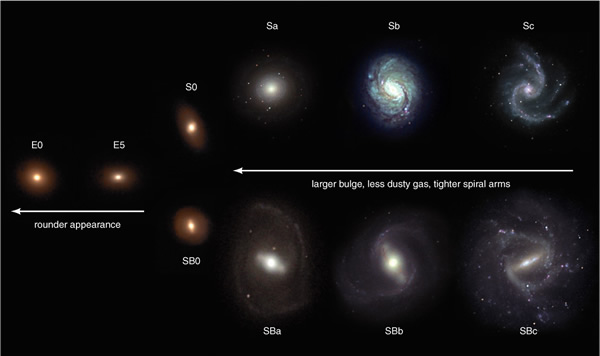
As shown in this diagram, there is another type of spiral galaxy called a "barred spiral". For reasons not yet understood, some spiral galaxies have a linear bar feature in their centers from which two arms emanate (the Milky Way appears to have such a feature):
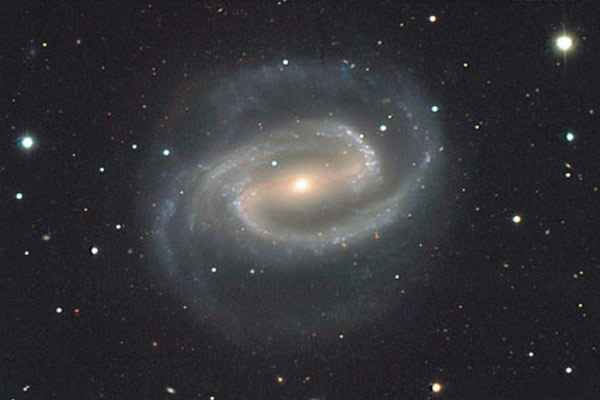
There are a bunch of galaxies out there that are neither spiral galaxies or elliptical galaxies. They have irregular shapes, without any clear organization. These galaxies are called irregular. An excellent example of an irregular galaxy is the Small Magellanic Cloud, a companion galaxy that orbits the Milky Way:
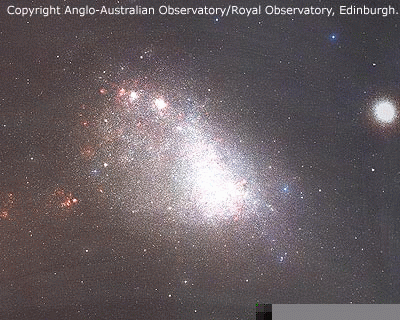
Irregular galaxies are usually quite small, and are loaded with star formation regions. Some irregular galaxies, however, result from the merging, or collision with other galaxies, and we get very complex shapes. Shown below is the result of the collision of two galaxies:
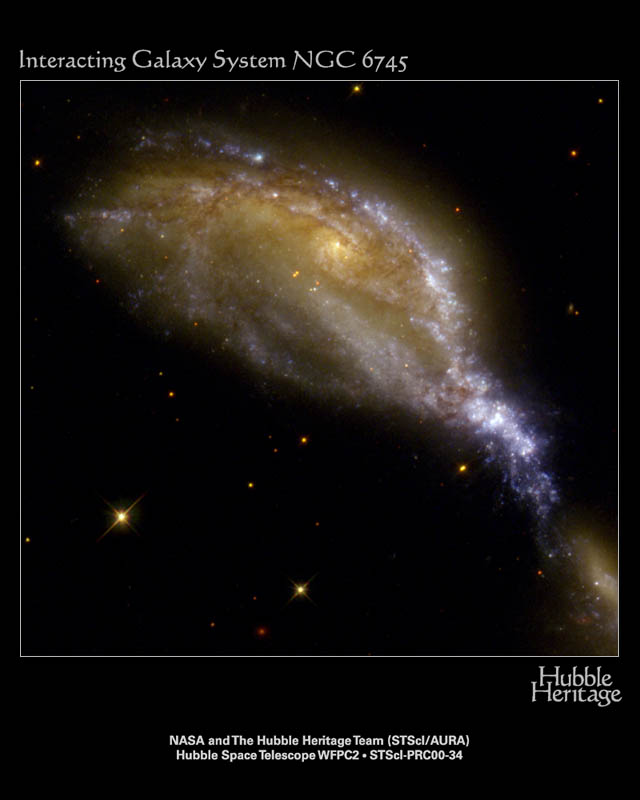
All galaxies that are not clearly spirals or ellipticals usually get classified as irregular. The following table summarizes all the major things about the nature of the different types of galaxies.
| Galaxy Characteristics | ||||||
|---|---|---|---|---|---|---|
| E0-E7 | S0 | Sa | Sb | Sc | Irr | |
| Nuclear Bulge | "All Bulge" No disk |
Bulge & Disk | Large | Interm. | Small | None |
| Spiral Arms | None | None | Tight/Smooth | Interm. | Open/Clumpy | Occasional traces |
| Gas | Almost none | Almost none | ~1% | 2-5% | 5-10% | 10-50% |
| Young Stars HII Regions |
None | None | Traces | Many | Lots | Dominates Appearance |
| Stars | All Old (~ 1010yr) |
Old | Some young | Mix young/old | Lots of young | Mostly young (but some v. old) |
| Spectral Type |
G-K | G-K | G-K | F-K | A-F | A-F |
| Color | Red | Red | Red | Red in bulge, bluish arms | Blue arms, tiny red bulge | Blue |
| Mass (MSun) |
108-1013 | (More) 1012-109 (Less) | 108-1011 | |||
| Luminosity (LSun) |
106-1011 | (More) 1011-108 (Less) | 108-1011 | |||
In the local Universe, spiral galaxies greatly outnumber ellipticals and irregulars: 75% spirals, 20% ellipticals, and 5% irregulars---but this is among "big" galaxies, the smaller galaxies are dominated by dwarf spheroidal.
1From: http://www.users.zetnet.co.uk/pete/Galaxieshtm.htm